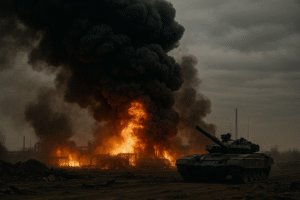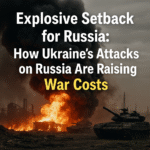The ongoing war between Ukraine and Russia continues to evolve, but a new development is striking hard, not just on the battlefield, but on Moscow’s wallet. Ukraine’s attacks on Russia have taken a strategic turn, targeting critical infrastructure, fuel depots, and logistical hubs deep inside Russian territory. These assaults are not just symbolic; they are tactical blows designed to jack up the financial and military burden on Russia.
Ukraine’s Attacks on Russia Are Changing the Game
In recent months, Ukraine has launched a series of well-coordinated attacks on Russian oil refineries, railway junctions, and ammunition storage units. These strikes, many executed using long-range drones and Western-supplied weaponry, are hitting Russia where it hurts the most—its economic and military supply chain.
This new strategy by Ukraine is having a compound effect. Russia is now forced to spend billions on rebuilding damaged sites, rerouting logistics, and increasing internal defence mechanisms. Ukraine’s attacks on Russia are now not only a tool of resistance but a calculated strategy to exhaust Russia’s resources.

Why Ukraine’s Attacks on Russia Are Financially Devastating
Infrastructure Damage Means Billions in Repair Costs
Each targeted oil refinery or railway bridge destroyed by Ukrainian forces costs Russia hundreds of millions to repair. For example, a single oil facility targeted in April 2025 cost an estimated $400 million to restore, not to mention the loss in production revenue.
Moreover, Russia’s defence spending has ballooned by over 70% since the war began, much of which is now redirected to domestic defence efforts due to Ukraine’s attacks on Russia.
Military Reallocation Leads to Strategic Weakness
To protect internal assets, Russia has had to reposition key units from the frontline to defend its borders. This move has diluted the strength of its ground forces in Eastern Ukraine. That shift offers Ukraine new offensive opportunities and keeps Russia in a constant state of military overstretch.
Psychological and Political Impacts of Ukraine’s Attacks on Russia
Beyond the financial costs, these strikes are creating unrest within Russian borders. Russian citizens, once feeling distant from the war, are now directly affected by blackouts, fuel shortages, and infrastructure damage. This shift is eroding public support for the conflict.
Even the Kremlin’s propaganda machine is struggling to maintain its narrative in the face of rising costs and increasing public dissatisfaction. Ukraine‘s ability to strike deep within Russian territory is sending a message: no part of Russia is truly safe.
Ukraine’s Attacks on Russia: A Smart Tactical Play
Military analysts suggest that Ukraine is adopting a hybrid war strategy—combining guerrilla-style attacks with advanced drone warfare. This approach, although less costly than full-scale combat, yields maximum damage in return.
By forcing Russia to overspend and redirect resources, Ukraine is effectively flipping the power dynamics. It’s a move that weakens the invader without draining Ukraine’s own stretched resources.
What’s Next in This High-Cost Battlefield?
The war is far from over, but Ukraine’s approach is sending ripples through Russian military planning. The Kremlin now faces two fronts: the battlefield and its collapsing economic stability. With the help of NATO and evolving drone technologies, Ukraine is likely to continue this pressure strategy.
Future attacks may target cyber infrastructure and satellite systems, escalating the cost of war for Russia even further.
📌 Conclusion
Ukraine’s attacks on Russia are proving to be more than military resistance—they are becoming financial warfare. By striking economic arteries and forcing Russia to defend from within, Ukraine is turning the war into a multi-dimensional conflict where money, morale, and strategy are all at stake.
If this pattern continues, the costs for Russia—militarily, economically, and politically—may reach unsustainable levels. What began as a defensive war has now evolved into a calculated disruption strategy that’s reshaping modern warfare.
Moreover, the psychological pressure placed on Russian citizens and the increasing domestic instability within Russia could eventually alter the Kremlin’s policy decisions. Global powers are also watching closely as the consequences of Ukraine’s attacks on Russia ripple into the international energy market, defence spending trends, and regional diplomacy.
Ukraine, despite being a smaller force, is showcasing how strategic precision and asymmetric warfare can challenge even the most formidable adversaries. In this new era of modern conflict, brains often outweigh brawn, and Ukraine seems to understand that well.
As the war continues to unfold, one thing is clear: Ukraine’s attacks on Russia are not only defending sovereignty—they are redefining the cost of aggression in today’s geopolitical landscape.











